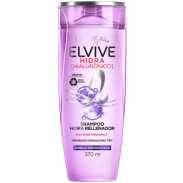Comparison between CeraVe Moisturizing Cream vs. Elvive Hidra Hialurónico Shampoo
Find out which product is better for your skin.
Ingredients in both products 5
Components only in CeraVe Moisturizing Cream 19
Glycerin, Cetearyl Alcohol, Caprylic/Capric Triglyceride, Cetyl Alcohol, Ceteareth-20 and 14 more. Show all.
Uniqueness: 79.2%
Components only in Elvive Hidra Hialurónico Shampoo 25
Sodium Laureth Sulfate, Sodium Lauryl Sulfate, Cocamidopropyl Betaine, Sodium Chloride, Glycol Distearate and 20 more. Show all.
Uniqueness: 83.3%
Face to Face
Components position by position
1
Water
1
Water
2
Glycerin
2
Sodium Laureth Sulfate
3
Cetearyl Alcohol
3
Sodium Lauryl Sulfate
4
Caprylic/Capric Triglyceride
4
Cocamidopropyl Betaine
5
Cetyl Alcohol
5
Sodium Chloride
6
Ceteareth-20
6
Glycol Distearate
7
Petrolatum
7
Hexylene Glycol
8
Potassium Phosphate
8
Guar Hydroxypropyltrimonium Chloride
Show others
Positive Effects
Find out what good effects the product has
Both products provide the following effects: Antioxidant, Moisturizing, Cleansing, Acne fighting, Softening, Soothing, Anti-aging, Rejuvenation, Antiseptic, Hair structure improvement, Hair gloss
Effects unique for Moisturizing Cream:
UV Protection, Deodorant, Regeneration, Protection, Hair volumizing, Hair protectionEffects unique for Hidra Hialurónico Shampoo:
Lightening, Lifting, Healing, Elasticity improvement, Antifungal, Hair conditioning, Hair growth stimulating-- Show more --
ECO Metrics
Find out how eco-friendly the components are
Vegan
No
No
Cruelty free
No
No
Reef safe
Yes
Yes
Ozone layer safe
Yes
Yes
Organic score
natural
7 out of 24
29%
chemical
13 out of 24
54%
natural
7 out of 30
23%
chemical
20 out of 30
67%
Concerns
Pay attention to this information
-- Extra information --
Components by Skin Type
Find out what components are good or bad for your skin type
Dry skin
Positive: 3Negative: 0
Glycerin#2Sodium Hyaluronate#16Tocopherol#21
Oily skin
Positive: 0Negative: 1
Petrolatum#7
Sensitive skin
Positive: 0Negative: 0
Dry skin
Positive: 1Negative: 2
Sodium Hyaluronate#15Sodium Laureth Sulfate#2Sodium Lauryl Sulfate#3
Oily skin
Positive: 1Negative: 0
Salicylic Acid#22
Sensitive skin
Positive: 0Negative: 4
Lactic Acid#11Salicylic Acid#22Linalool#25Citric Acid#28

